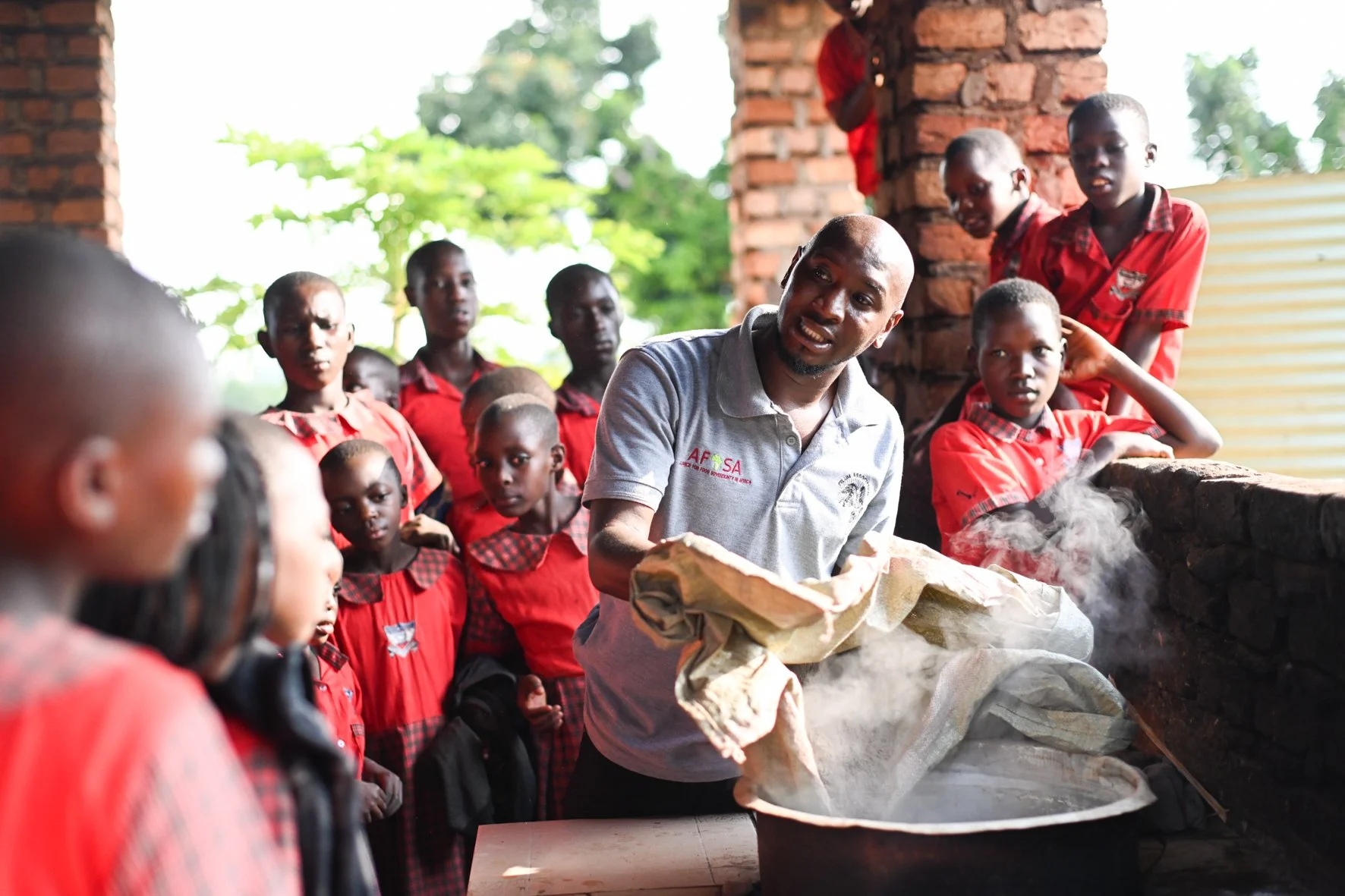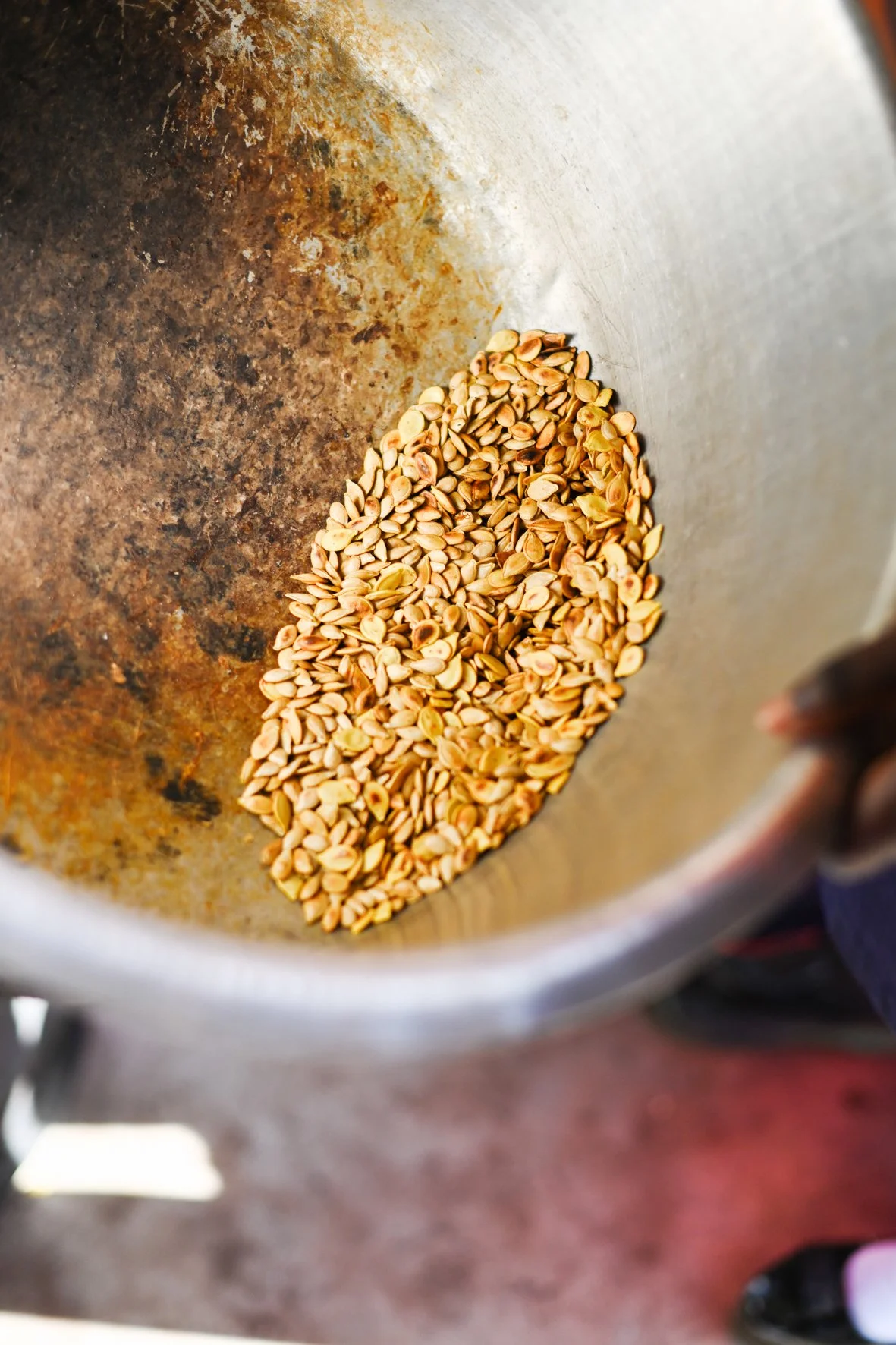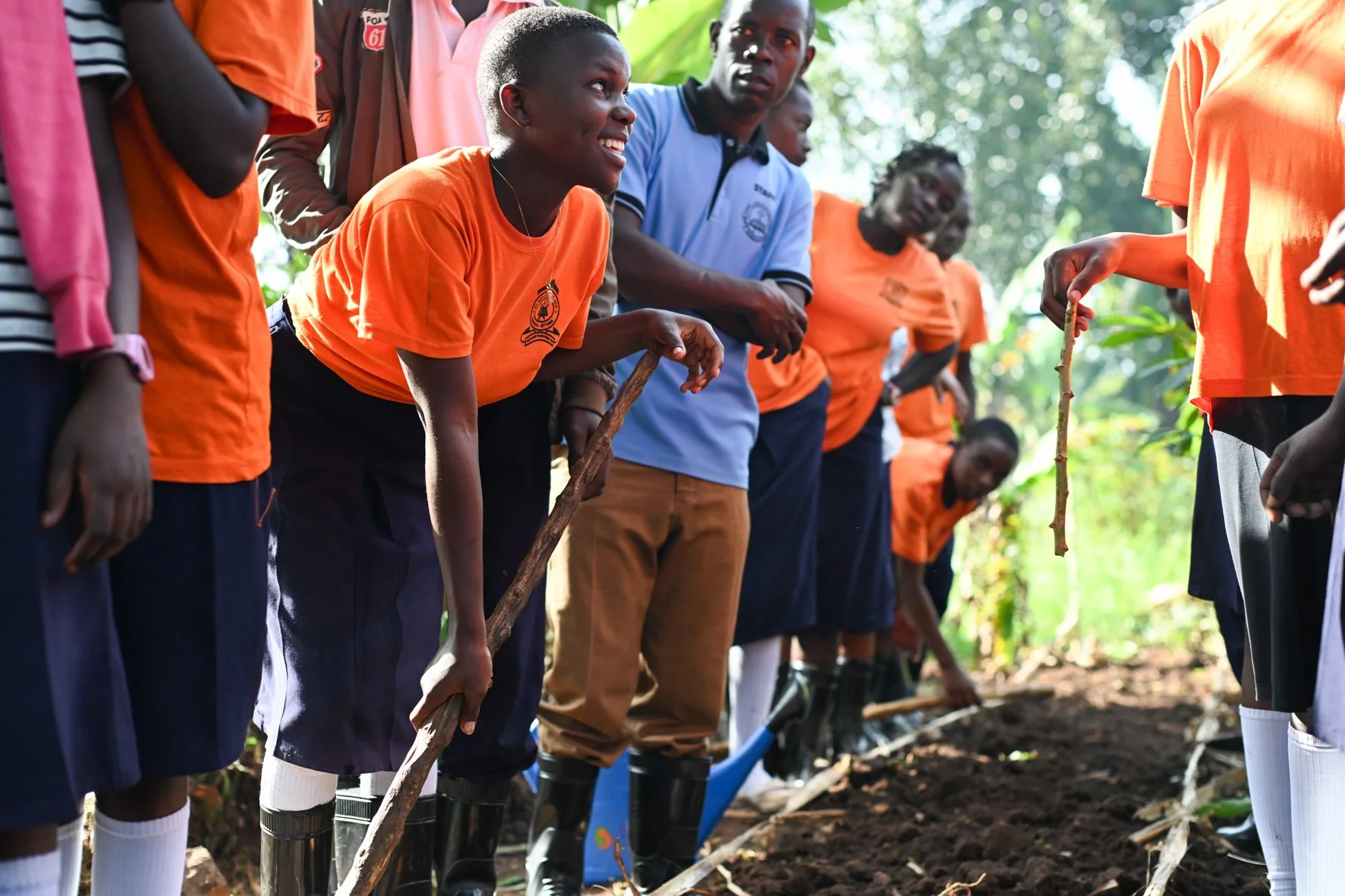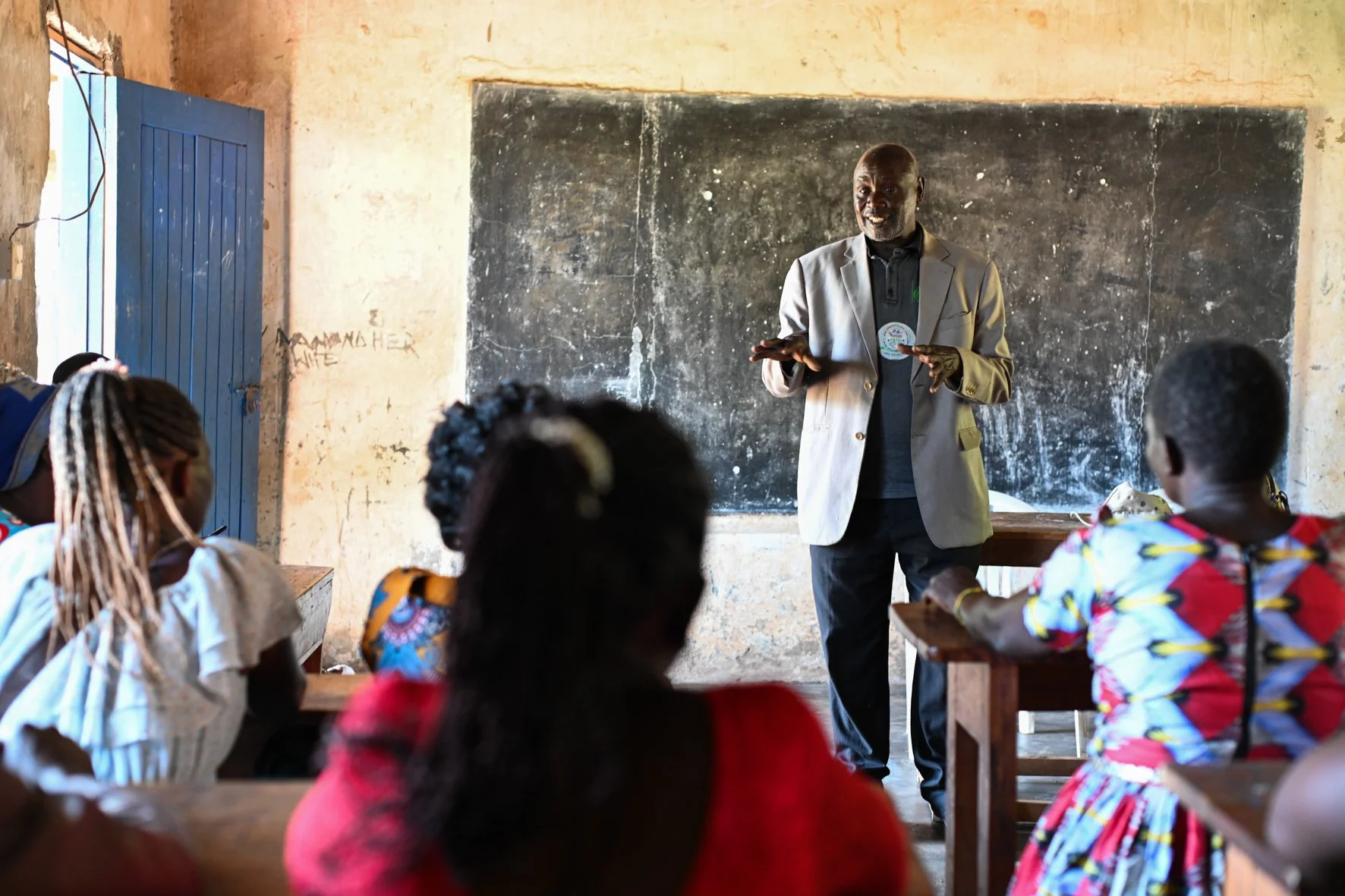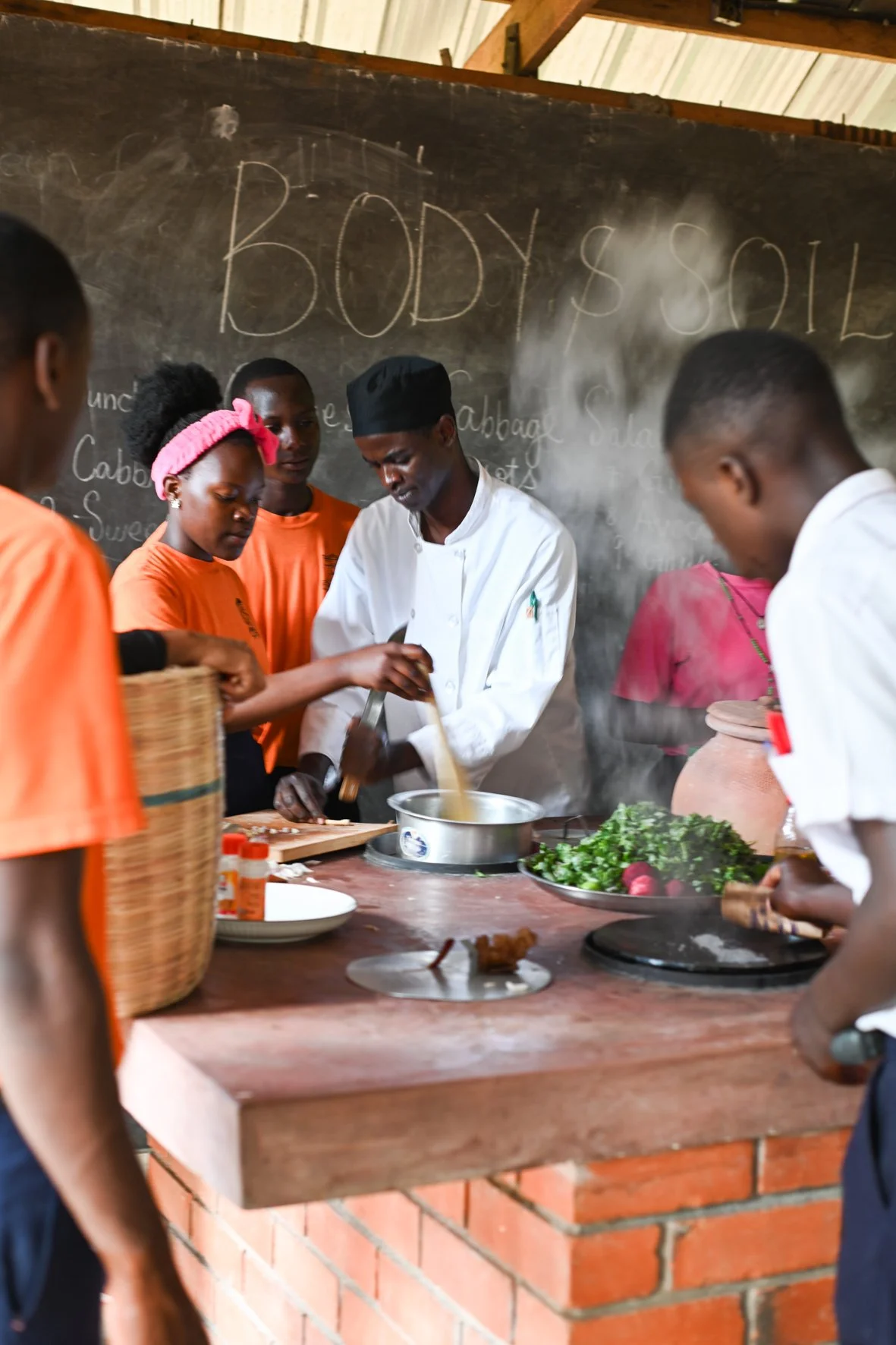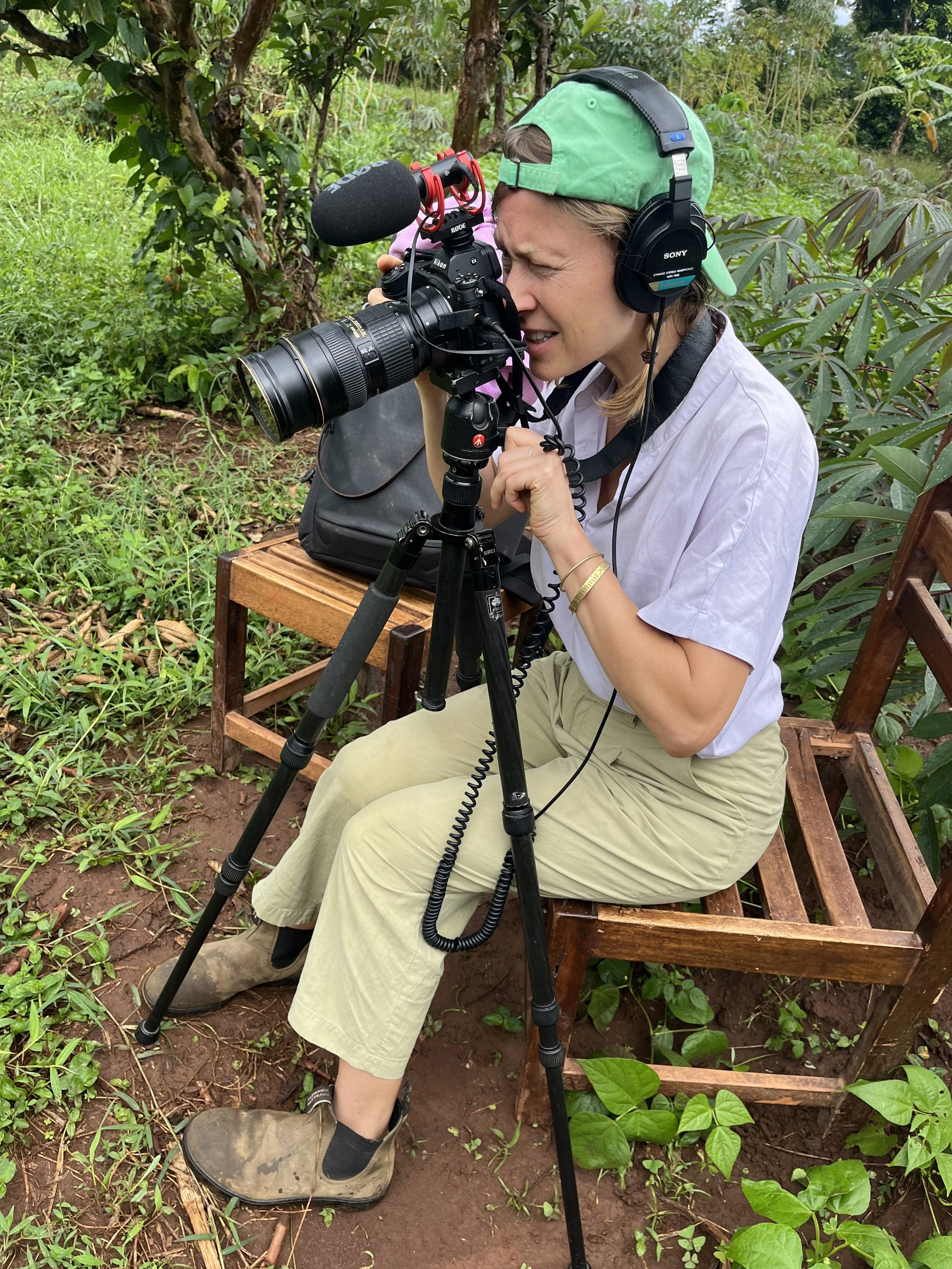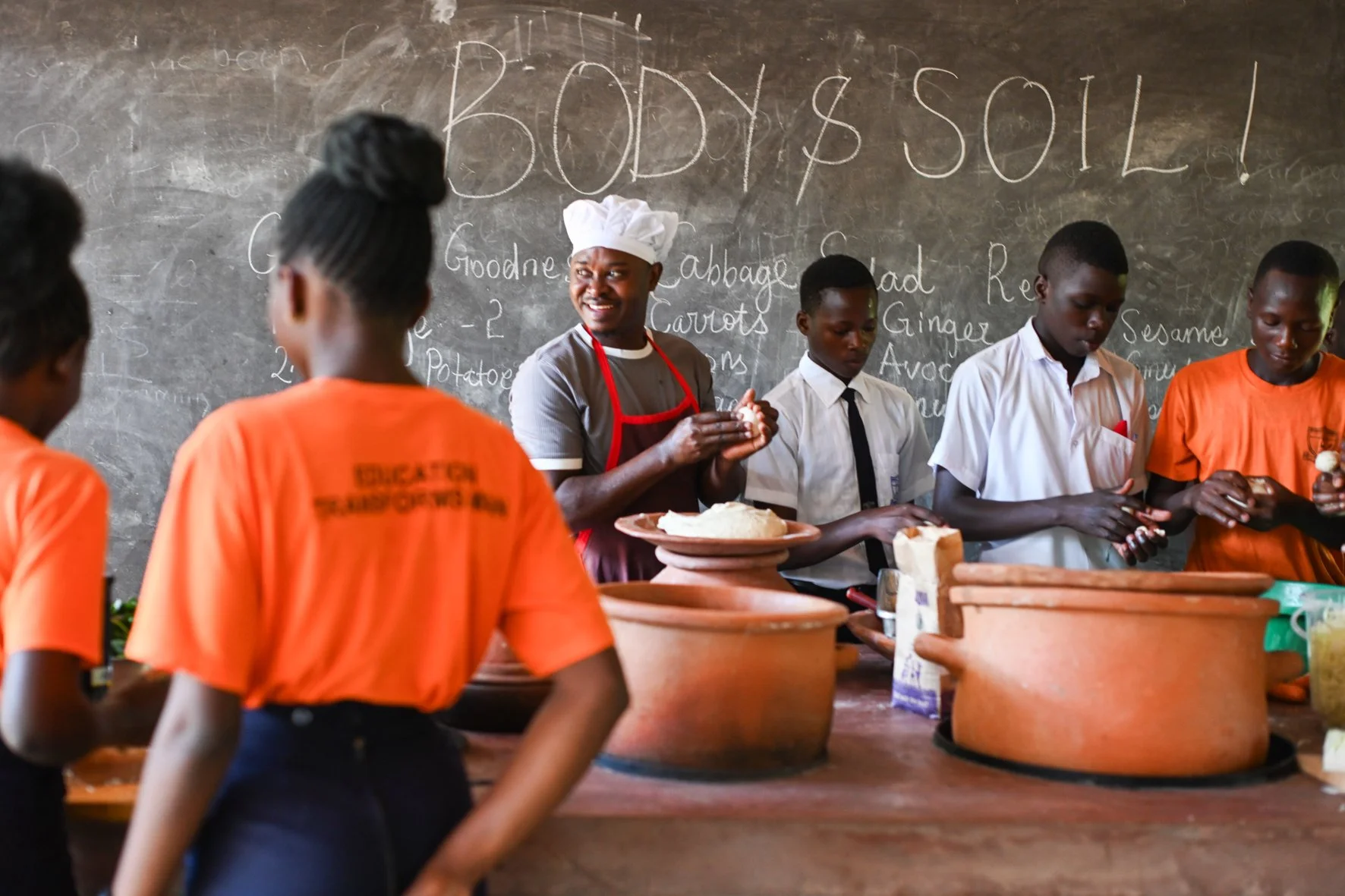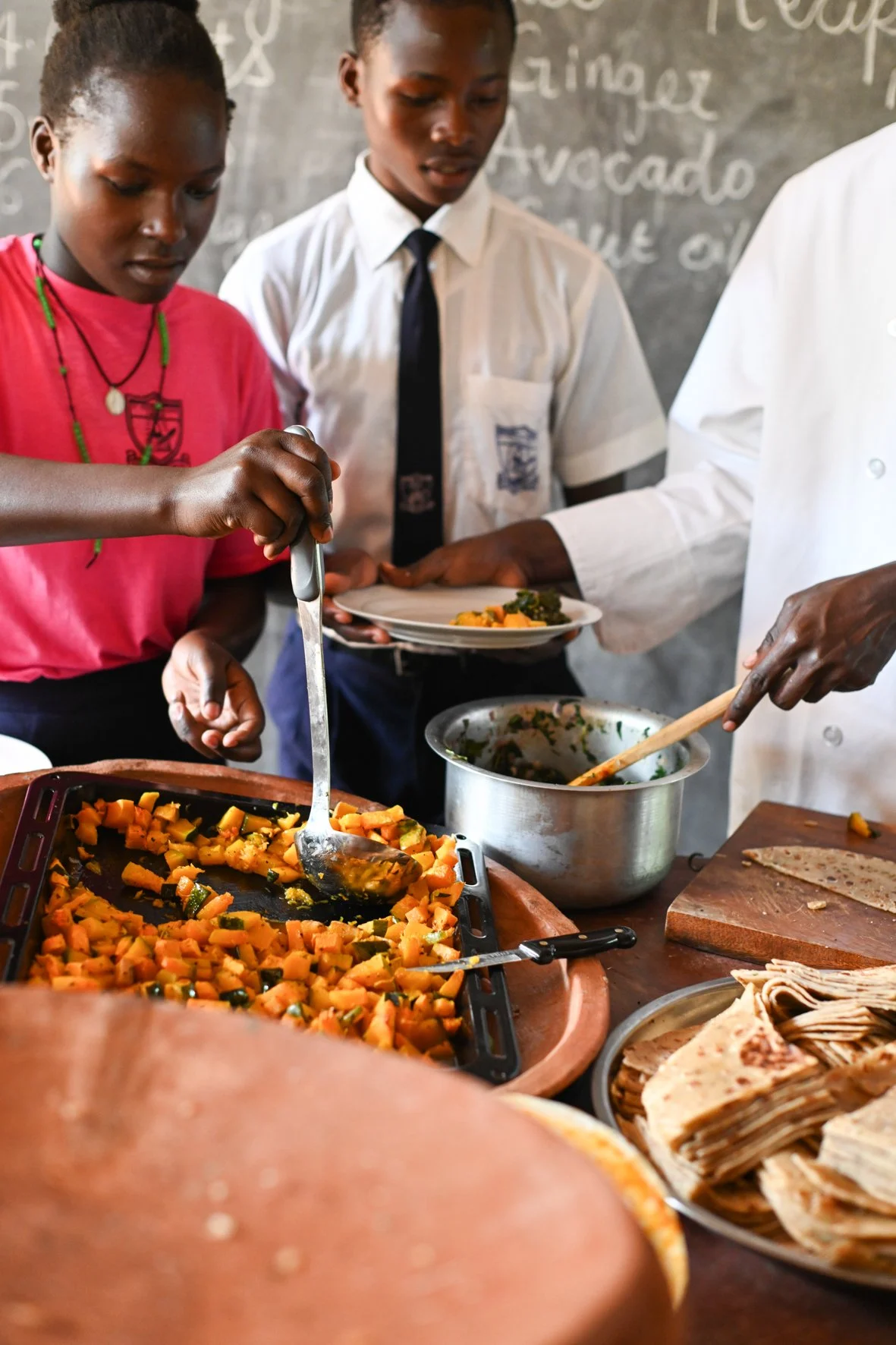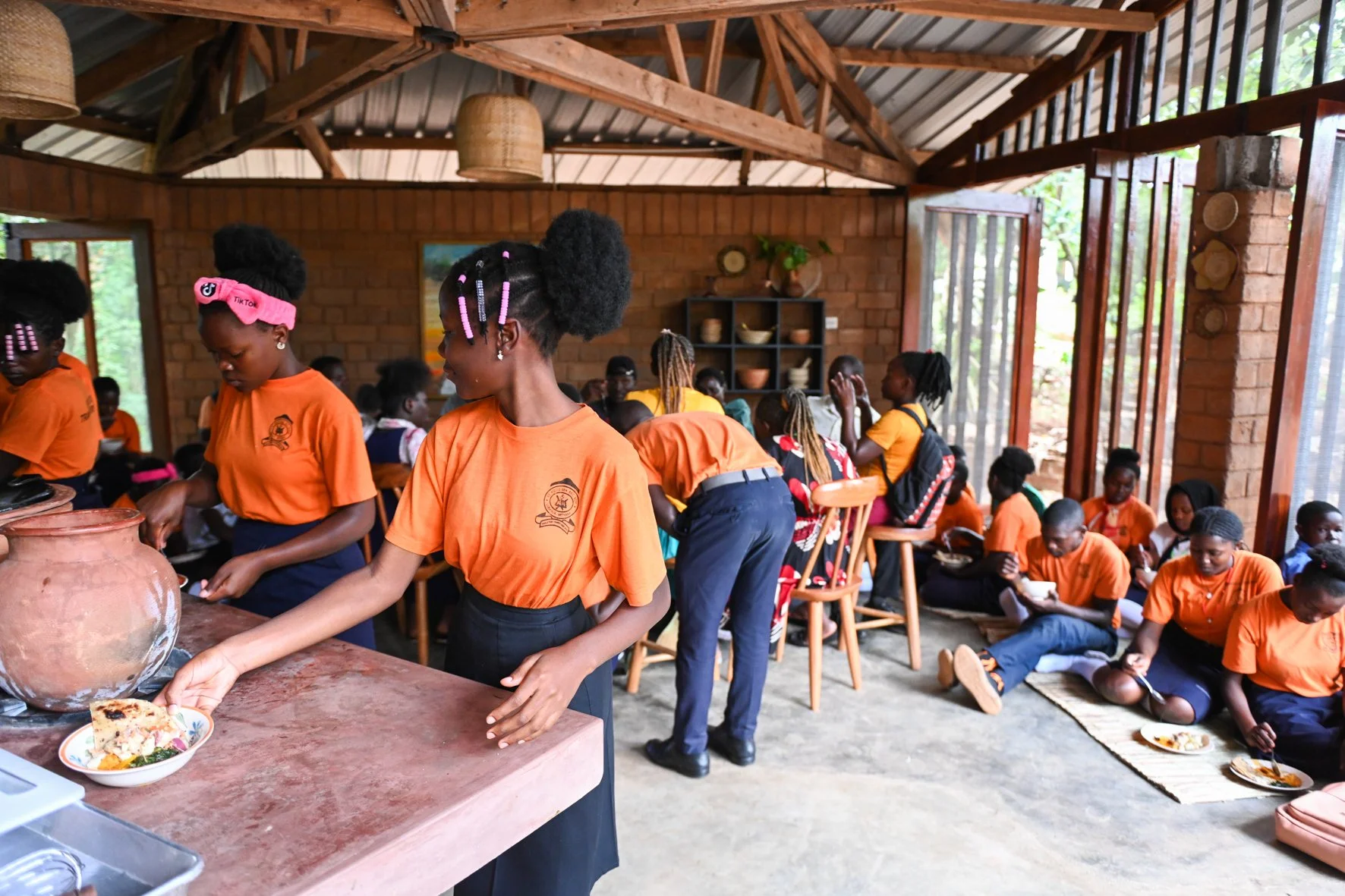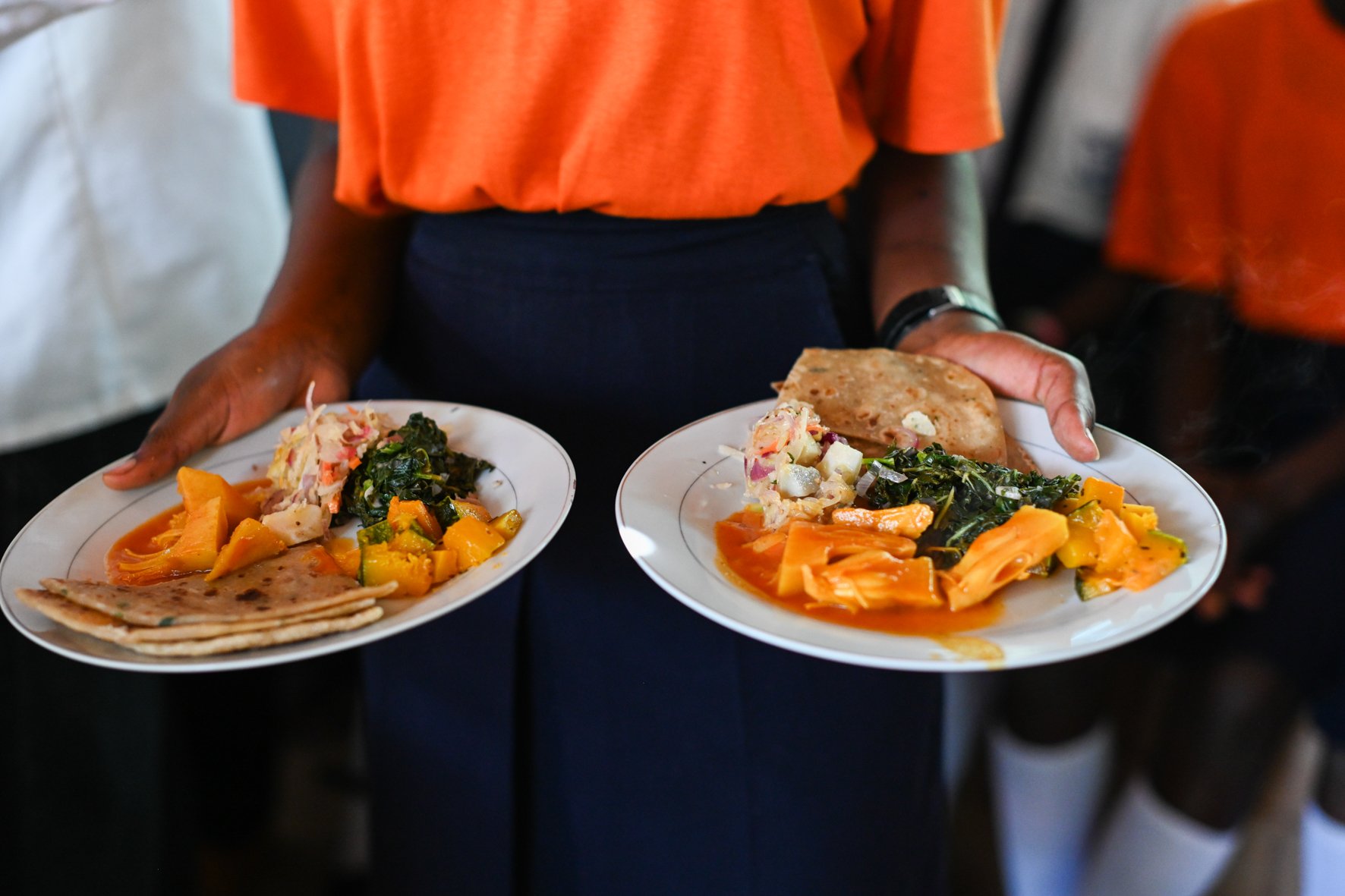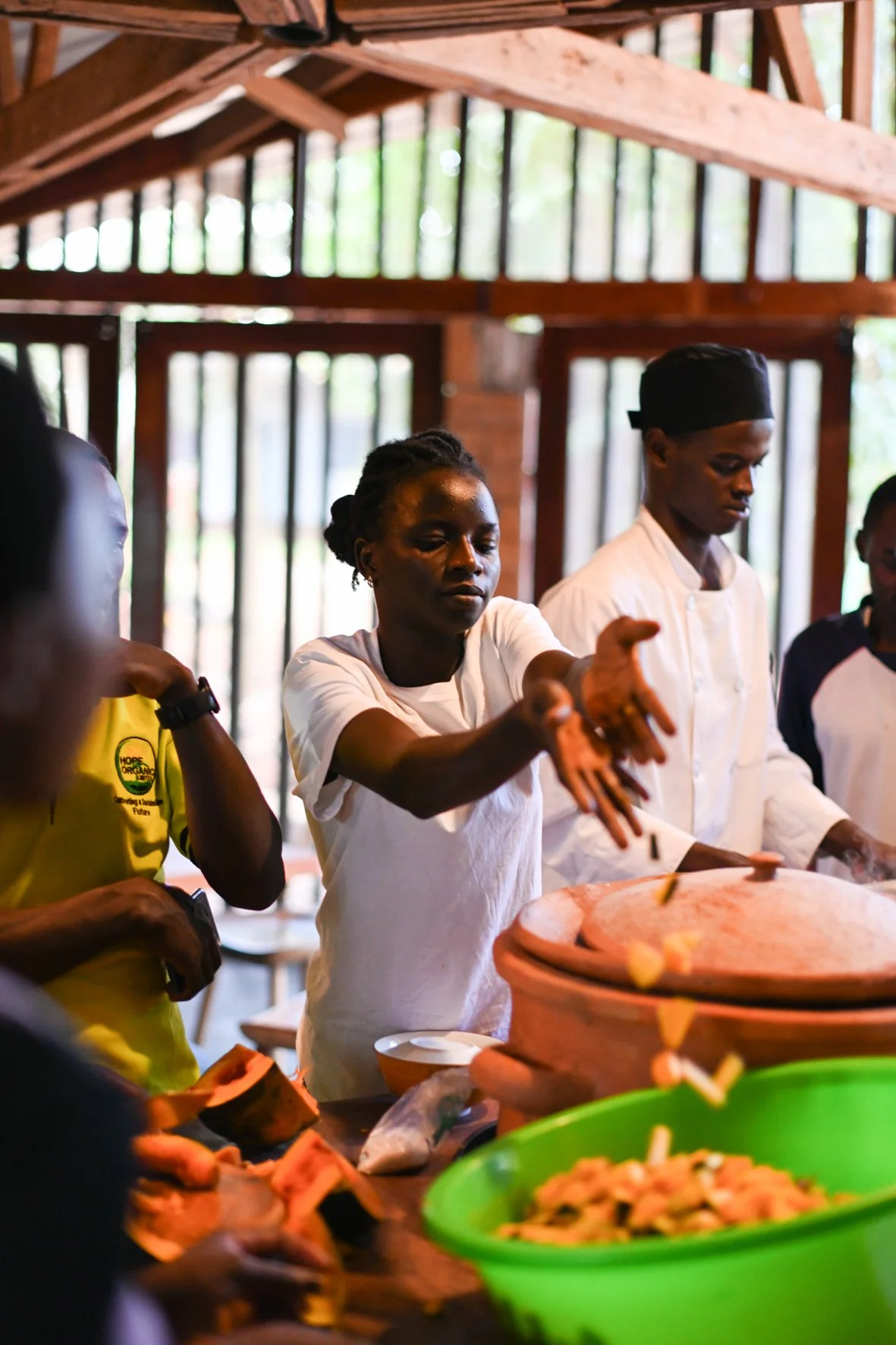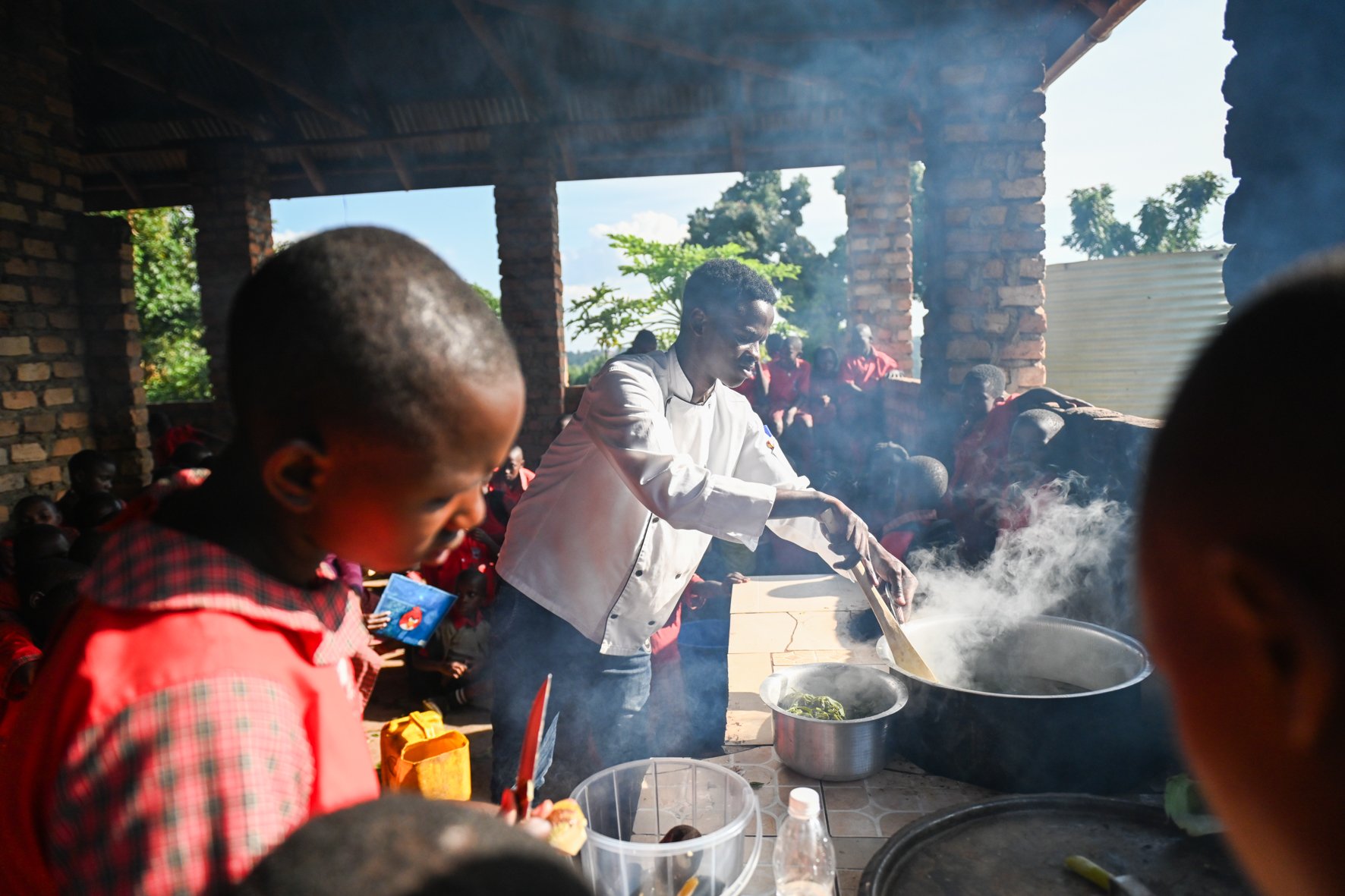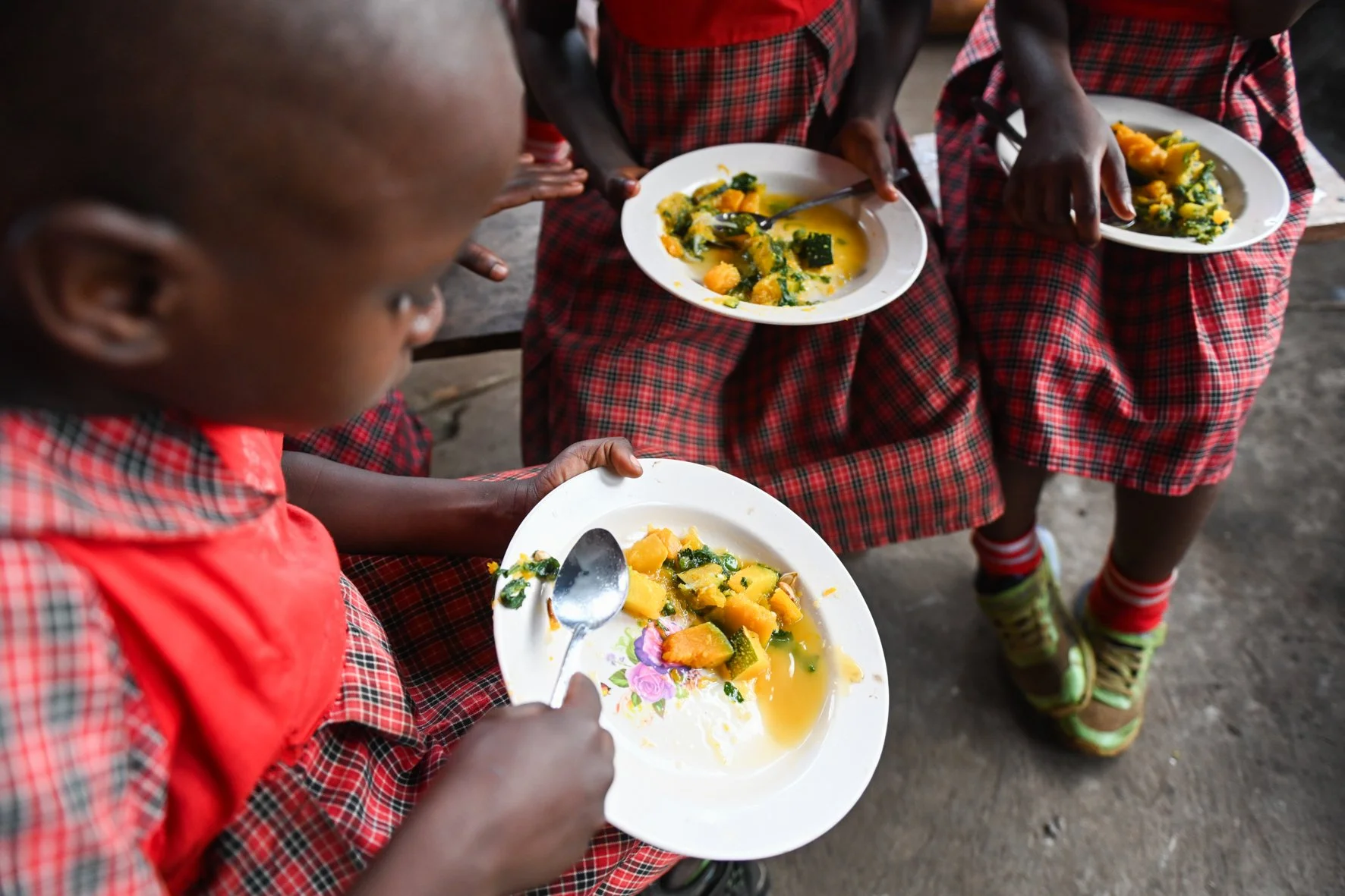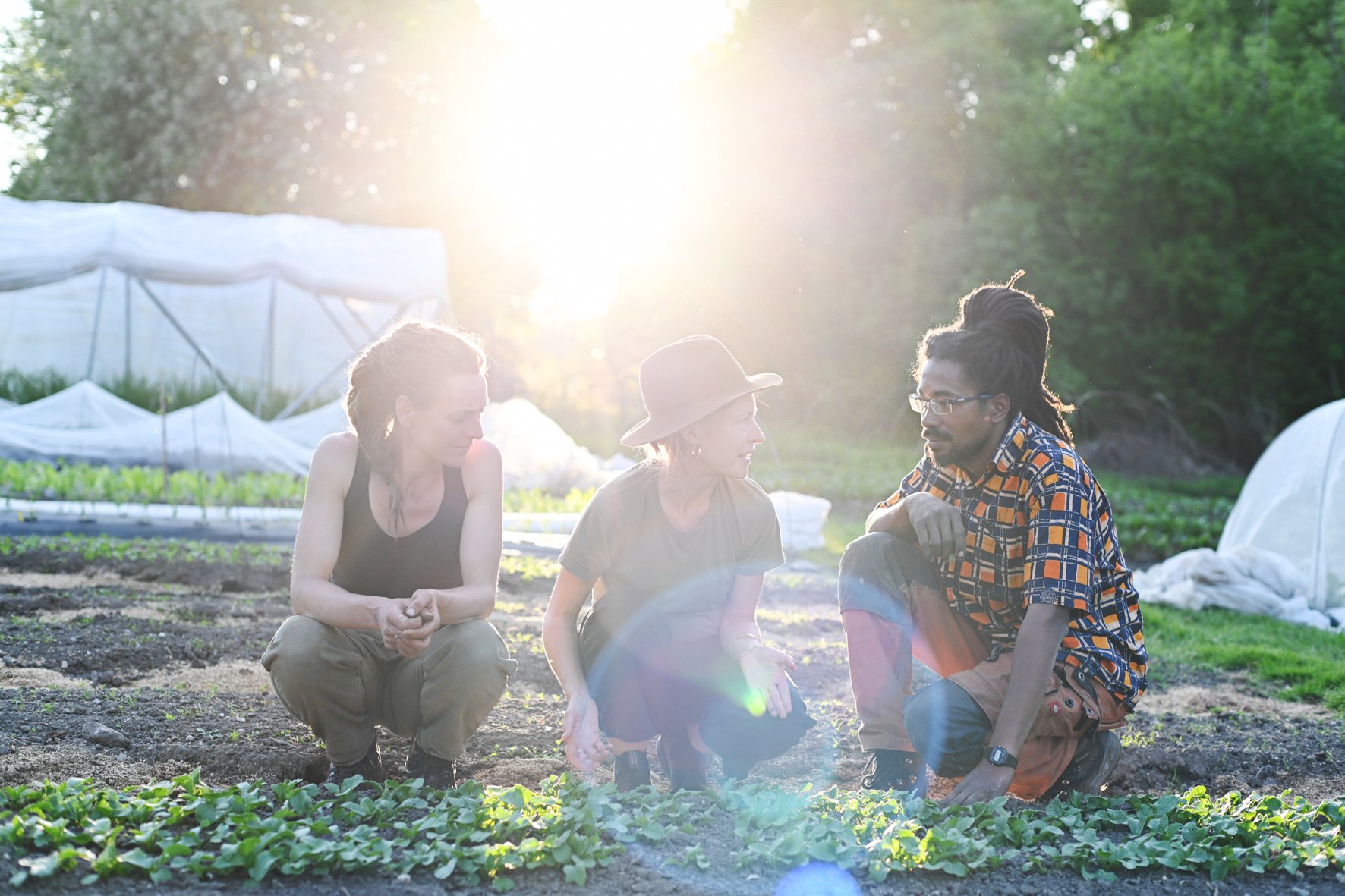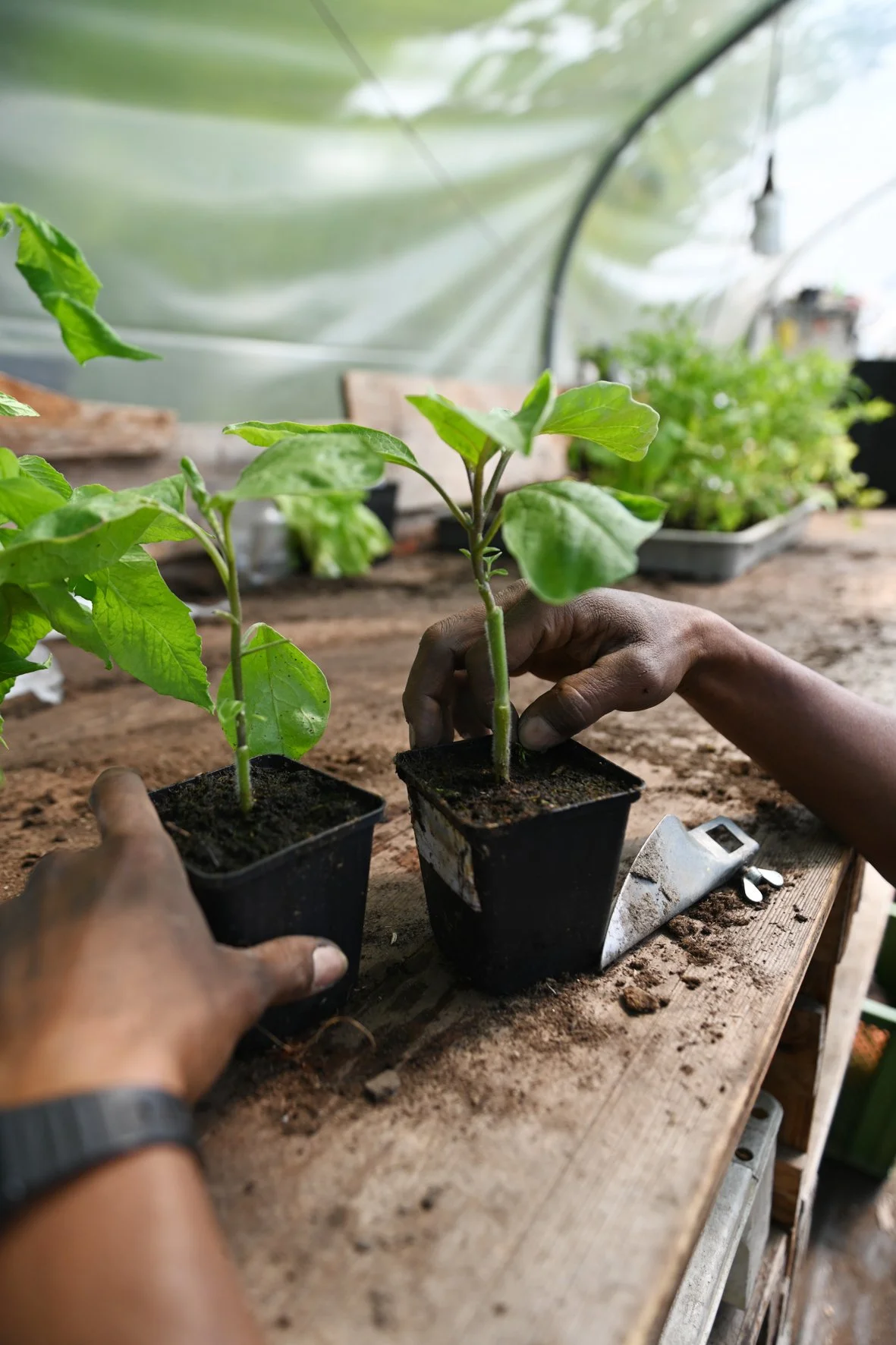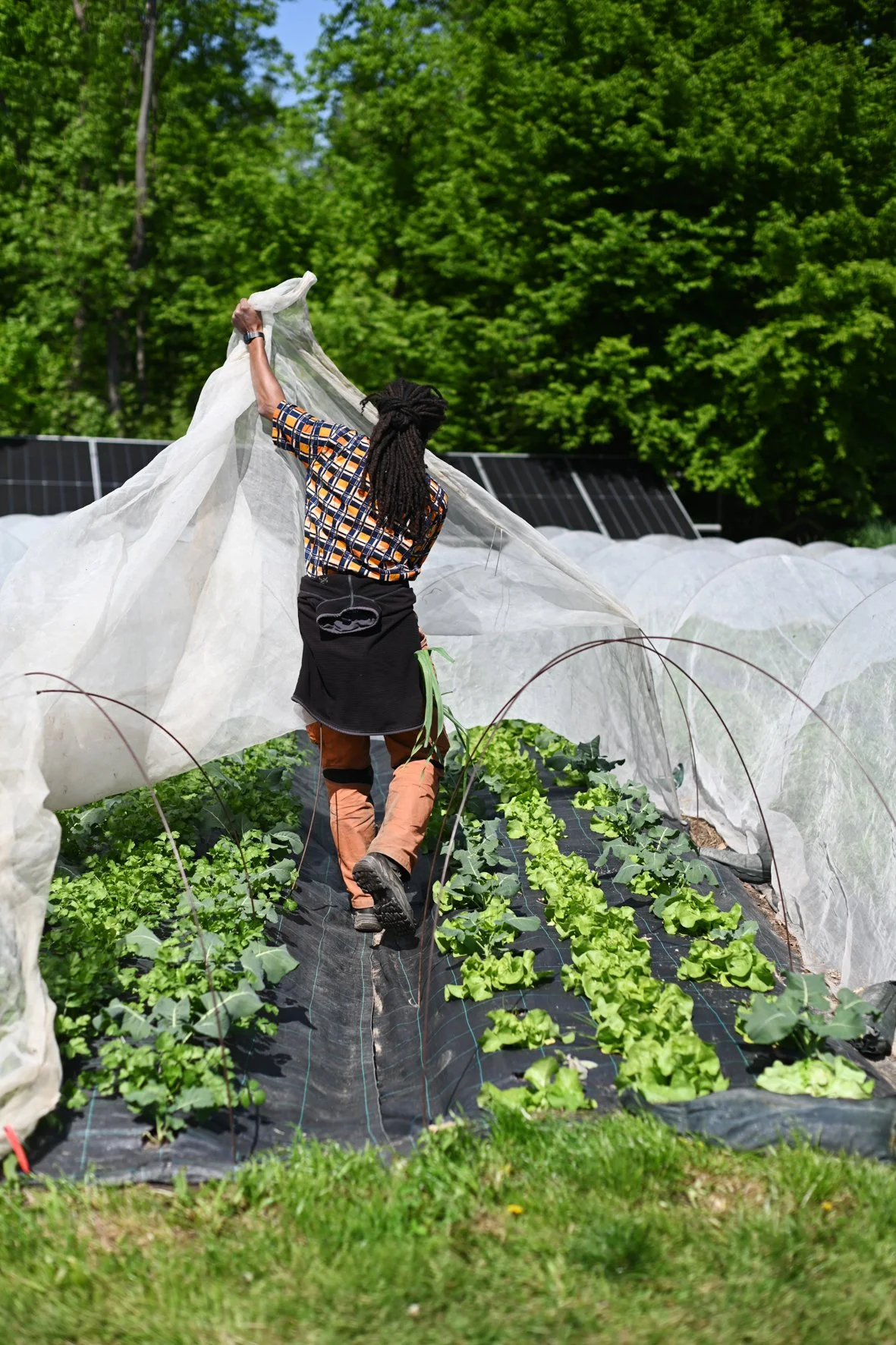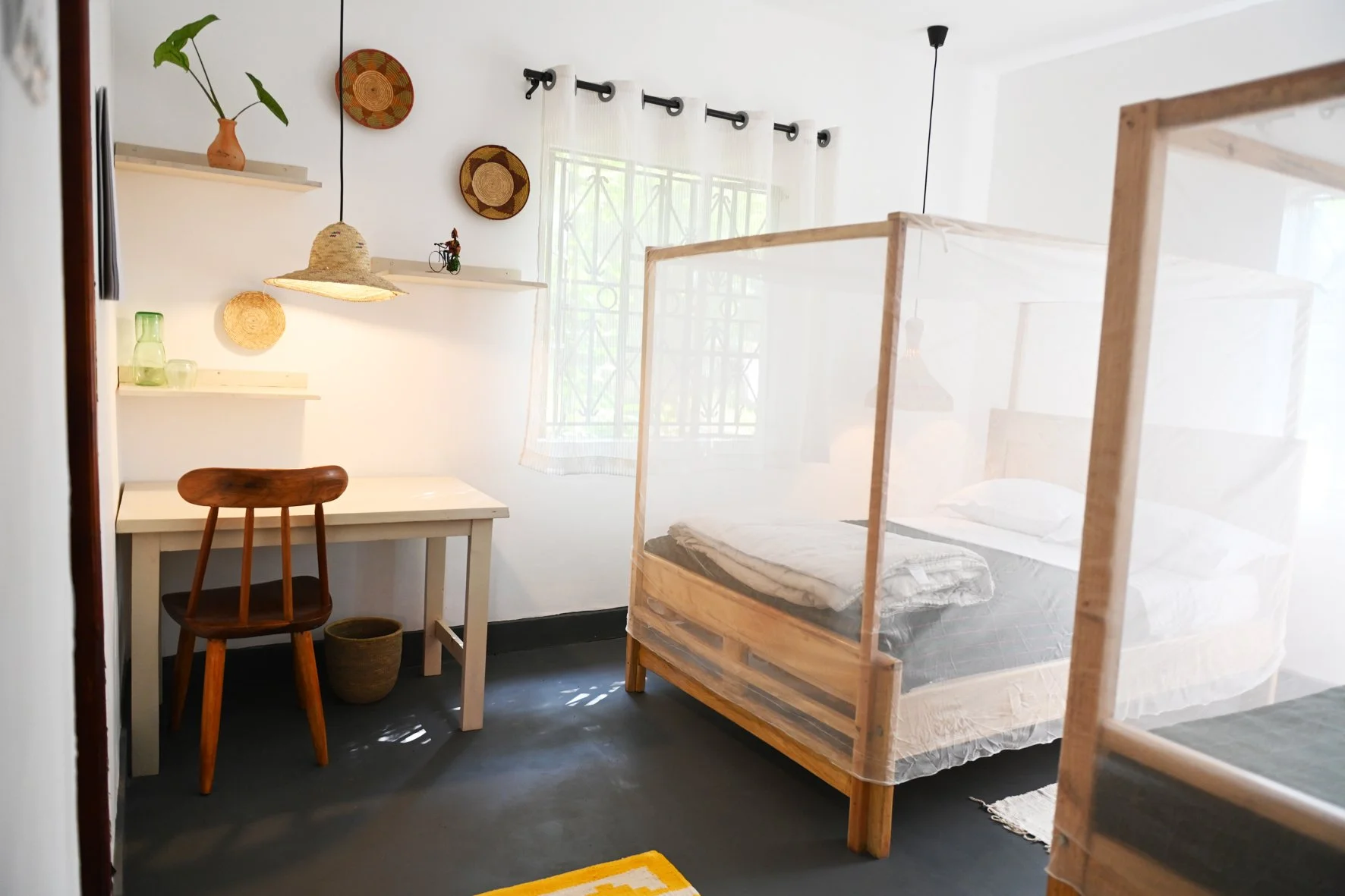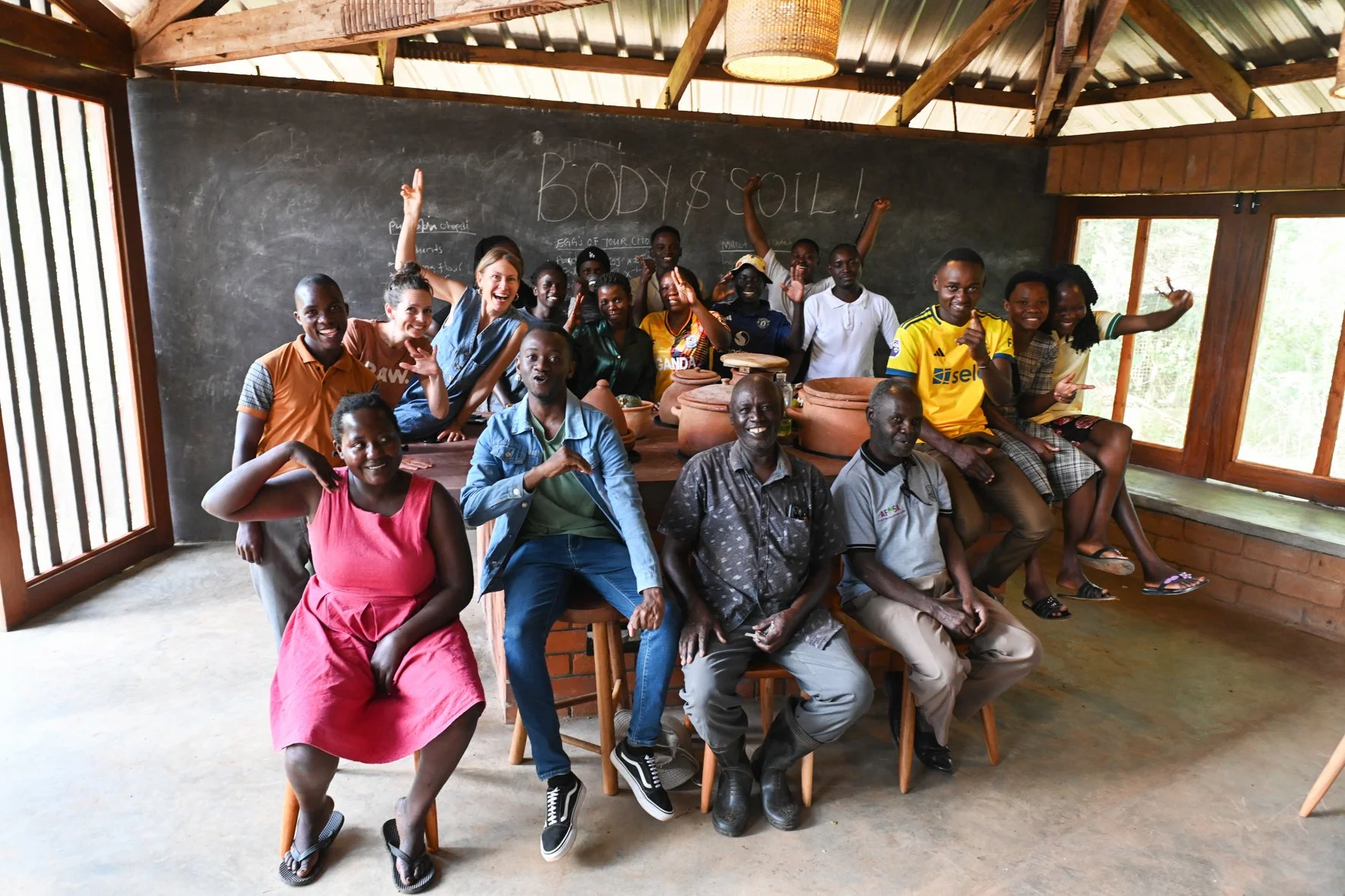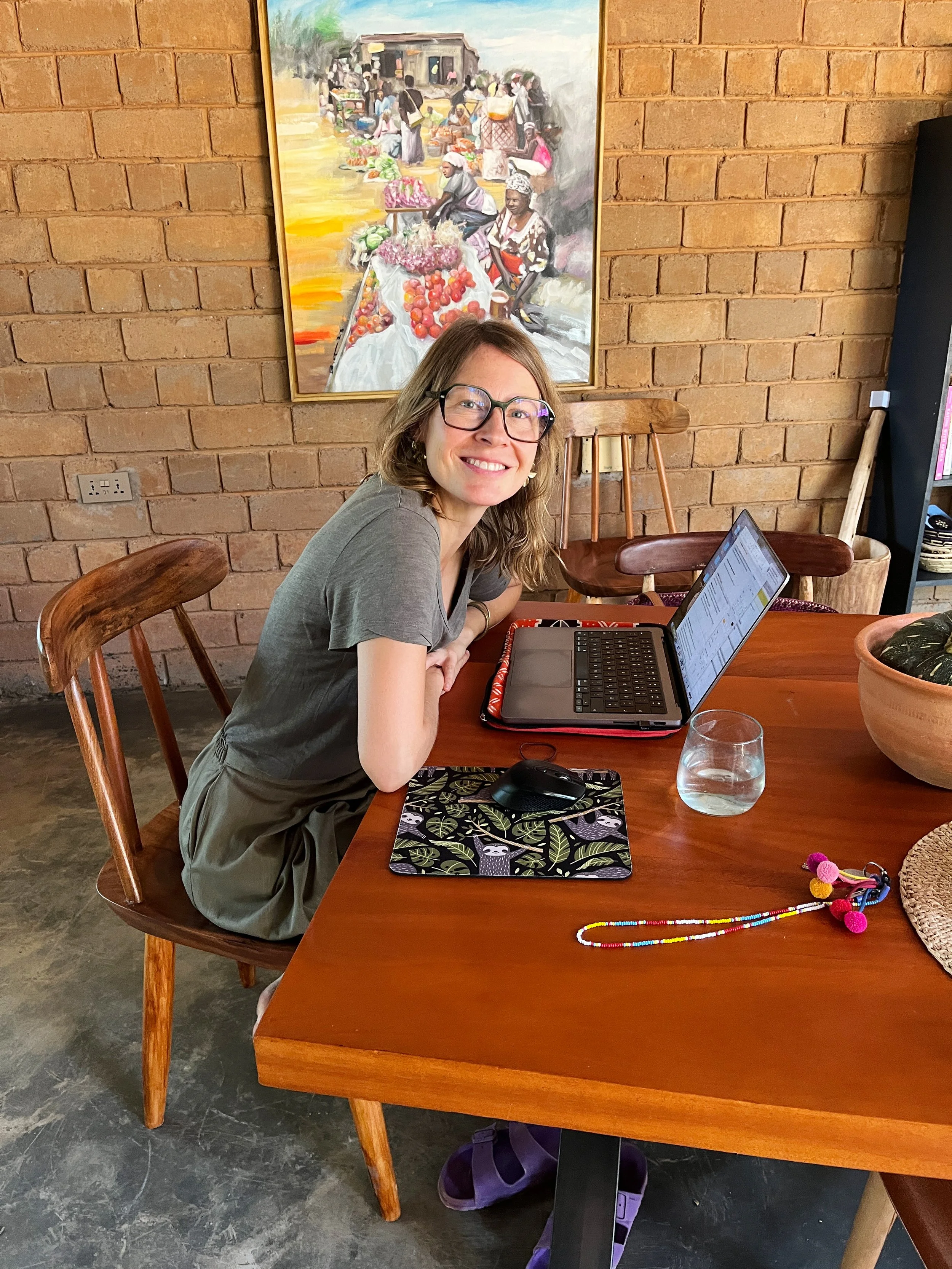“It’s the Small Things in Africa, that Make a Difference”
Above: Stuart Nyanzi giving a practical lesson at the community primary school on how to make organic pesticide.
“It’s the small things in Africa that make a difference,” Stuart Nyanzi said to me as we rattled back down a potholed road after a training at one of our community schools.
Stuart is the manager of the RUCID Organic College—and sort of like my right hand. BODY&SOIL wouldn’t be moving forward so fast without team members like him. He steps in wherever needed, whether it’s negotiating a deal or teaching how to make organic fertilizers and pesticides. He’s an all-rounder, a problem-solver, a friend—and someone who’s not afraid to tell me what he really thinks.
You probably know those quiet moments of doubt: Am I even qualified to do this?
And I don’t think that’s a bad question. It keeps me humble. It keeps me learning. Especially when I’m back in Europe, like now, the doubt sharpens: What makes me think—as a foreigner—that I can support people in changing their eating habits here, when even in Europe people struggle with this?
But I take a breath and break it down—for myself and for you. I’m not here to change entire systems alone. I’m here as a nutritionist, a connector, and a storyteller—to make solutions visible and shareable. I’m part of a team: agronomists, teachers, chefs, students. Experts from Uganda and beyond. Rather than erasing traditions, we’re reviving and adapting them—so they can live on, in ways that make sense today.
To my friends in Germany: Remember when organic supermarkets were niche? Now many of us shop organic—some exclusively. It’s not cheap, but something shifted—slowly. Step by step. With new information. Social media played a huge role.
Suddenly, recipes and solutions were just a swipe away.
That’s not yet the reality in much of rural Africa. In many areas, there’s no stable internet, few smartphones. But that’s changing. And when people do get smartphones, they use them! We want to be ready for that moment to reach them.
Above: Secondary school students demonstrate the concept of BODY&SOIL through a dish for their parents—a pumpkin dish using everything from seed to leaf.
A Little Big Moment
There’s a lot happening right now, but let me share a small, powerful glimpse of our recent progress. A few weeks ago, on a Friday morning, we invited a group of parents from the communtiy high school we’re working with to visit RUCID College and BODY&SOIL. Just days earlier, their children had shown them the nursery and school gardens we’re developing—and cooked for them: a BODY&SOIL pumpkin stew made from seed to leaf. The students prepared the meal together with our chef Kalefu, using the school’s new energy-saving stove.
Five pumpkins were enough to feed the entire school and twenty adults. “It’s even cheap to make,” one teacher remarked. Parents, students, and teachers all loved it—it was a hit!
Above: Samuel Nyanzi introducing the parents to the BODY&SOIL program, while students show the seedlings in the school gardens we’ve started.
Samuel Nyanzi (RUCID’s director) and I spoke to the parents about our work establishing kids’ clubs—in nutrition, agriculture, and food processing. If students stay engaged, they can earn a practical certificate within a year—something tangible to build on, even if they can’t afford to finish school. A certificate in vegetable growing, for example, can open doors to job opportunities. One mother asked, “Can our children join even if we can’t pay school fees?” The answer: yes. The certificate becomes a reason to stay involved—for both students and their parents.
Then a mother stood up and shared how her 13-year-old daughter had come home after a session with us and cooked blackjack greens—a plant often dismissed as a weed—because she now understood its nutritional value. We’ve only been active in these schools for two months, yet the ripple effects are already visible, that's super motivating for the team!
A father asked, “Can we build a center to bring these foods to market, so our children can start small businesses?” Samuel explained in Luganda that this is our long-term goal. But for now, we’re offering what we can: a safe space to experiment, learn, and grow.
Then it was our turn to ask the parents a question. At this high school of 100 students, fewer than a third can afford the daily school lunch of just maize and beans. Most eat snacks—or nothing at all. This isn’t unusual; it reflects the reality in many community schools. That’s why we’re looking for sustainable solutions. Would the parents be willing to contribute some of their crops to help bridge the gap until the first school harvest is ready?
In return, we offered training in food processing—also so we can beginn to develop porridge mixtures together that are tastier, more nutritious, and longer-lasting than the usual posho (maize meal). All sixteen parents agreed. No money was exchanged—just a shared sense of community to create change.
Above: Parents bringing crops to RUCID as a contribution to school meals.
Below: Kalefu preparing lunch with the students in the BODY&SOIL energy-saving kitchen.
Then Friday Came… and So Did Everyone
Except it wasn’t just 16 parents at the gate. There was a miscommunication—and the entire school showed up. That’s when my German side kicked in—thinking: Wait… we didn’t plan for this! But my team handled it with ease.Stuart whispered calmly, “We’re going to split into groups. I’ll take some to the processing center. You take the nutrition club to the kitchen with Kalefu and Bonny—we’ll cook lunch for everyone.” It worked.
Kalefu and Bonny improvised with what we had, emptying our small food storage. Before we began, Elisha Ssebadduka, principal of RUCID, welcomed everyone. This organic college has been around for 30 years—yet most nearby farmers had never set foot here. Frear or respect for institutions is a real thing. But we want them to know: this place is open for them too.
During that time, I interviewed students, parents, and teachers to document what’s happening—so we can reflect, learn, and adapt. Ian, a 17-year-old student, told me that ever since he learned about the healing power of blackjack, his ulcers have started to improve. “I want to be like Silas when I finish school,” he said. Silas, one of our RUCID student-trainers,is becoming more than just a teacher—he’s a role model.
Katharina, 16, a boarding student, shared that both she and her mother struggle with ulcers. “When I go home, I want to teach her everything I’ve learned—especially how to grow food more efficiently. She’s a farmer.” But of course, ulcers aren’t the only challenge. Parents spoke openly about their daily struggles—limited land, poor market access, climate change. And yet, they’re eager and hungry to learn solutions.
Above: Silas teaching agriculture to the community high school students.
Below: Bonny doing what he loves most in the BODY&SOIL energy-saving kitchen.
"The BODY&SOIL nutrition sessions are the highlight of my week. They’ve changed the way I eat.”
As I listened, I watched Bonny picking herbs from our BODY&SOIL kitchen garden. He’s the college custodian—but also a self-taught baker. In his free time, he teaches women how to bake. A few days earlier, I’d asked him to join the BODY&SOIL team to help develop products from local flours. I believe investing in people works. When I told him, we both nearly cried—because we both felt seen, needed, and valued by each other.
“The B&S nutrition sessions are the highlight of my week. They’ve changed the way I eat,” he told me. “I feel better. I look better.”
At 12:30, we served lunch in a packed classroom: chapati with garden herbs and a rainbow of local vegetables. But what stood out most that day was the variety of feedback. One parent said, “If that pumpkin stew hadn’t tasted so good the other day, we wouldn’t have come back today.” Then they added, “Now—how can we get the recipes?”
After lunch, we invited parents to come again—and next time, to bring local seeds or even crops they no longer recognize. Together, we’ll prepare them or send them to the lab to explore their nutritional value. The goal is to grow the local seed bank we’ve already begun to build. As we closed the lunch, the head teacher stood up and said, “We’ll never forget this day or what you’re doing here. It may seem small to you, but to us, it’s something we never expected.” But he was wrong about one thing: it doesn’t feel small to me at all. As much as this work is changing others, it’s changing me too.
What’s Next
When I return in June, we’ll begin creating bite-sized online educational videos that share practical knowledge in agroecology and nutrition—from soil to plate—always grounded in local wisdom. This will help us test what works best for children, teachers, and parents, and guide us in adapting or building what’s needed next—what can be scaled, both online and offline.
During this practical process, we’ll also be collecting recipes for the BODY&SOIL community cookbook: recipes made from what people can grow in their own gardens. They’ll be tried-and-tested dishes from children, RUCID students, and parents—affordable, nutritious, and entirely based on locally available ingredients. We’re asking: can these dishes inspire people to bring more diversity into their diets and fields?
My dream is that in 10 to 20 years, school meals will look different—more nutritious, more diverse, and deeply rooted in local plants—because of the small seeds we’re planting today.
Right now, I’m in Germany for the whole of May. Last Wednesday, I visited
BIOSAIN in Austria, where Tristan Toé and his wife Jahwezi Graf are developing Nakôbio—an educational program to teach farmers how to grow in living soil, starting in Mali. Their focus: bio-intensive farming, climate-adapted seed breeding, and making small plots highly productive. I spent the day with them—hands in soil, minds buzzing—asking myself: How can we adapt this knowledge to Uganda’s soils? You can learn more about their pioneer work here: 🔗Nakôbio 📺 youtube.com/@nakobio
RUCID College holds deep knowledge too—but as the world shifts, we as a team are eager to connect with other experts across Africa who are working on grounded, real-world solutions: soil health, syntropic farming, indigenous plants, seed banking, holistic nutrition, and cooking. We've already made space for this kind of exchange—two guest rooms are ready and open. If you are one of these experts, drop me a line!
To end my journal today, I wanted to tell you about the painting behind me in the picture below. I bought it in January 2024 and promised myself I would hang it in the BODY&SOIL classroom—where it’s hanging today! Is that manifestation, or just the result of sticking with it? Whatever you want to call it, I’m grateful I've chosen this uncertain path. This work truly lights me up, because for the first time, I feel my talents are being put to good use. I’m incredibly proud of the small changes the BODY&SOIL team is making together. Or as Stuart put it:“This is different from one of those pre-funded projects where an outside organization decides what should be done. With BODY&SOIL, we build it together. We decide together, and we work until we can’t anymore—that’s us.”
More to come next month—when I’m back in Uganda. And by the way, send me a message if you’d like our amazing pumpkin stew recipe from Chef Kalefu. It’s really worth trying!
Thank you for reading, and thank you for being here!

